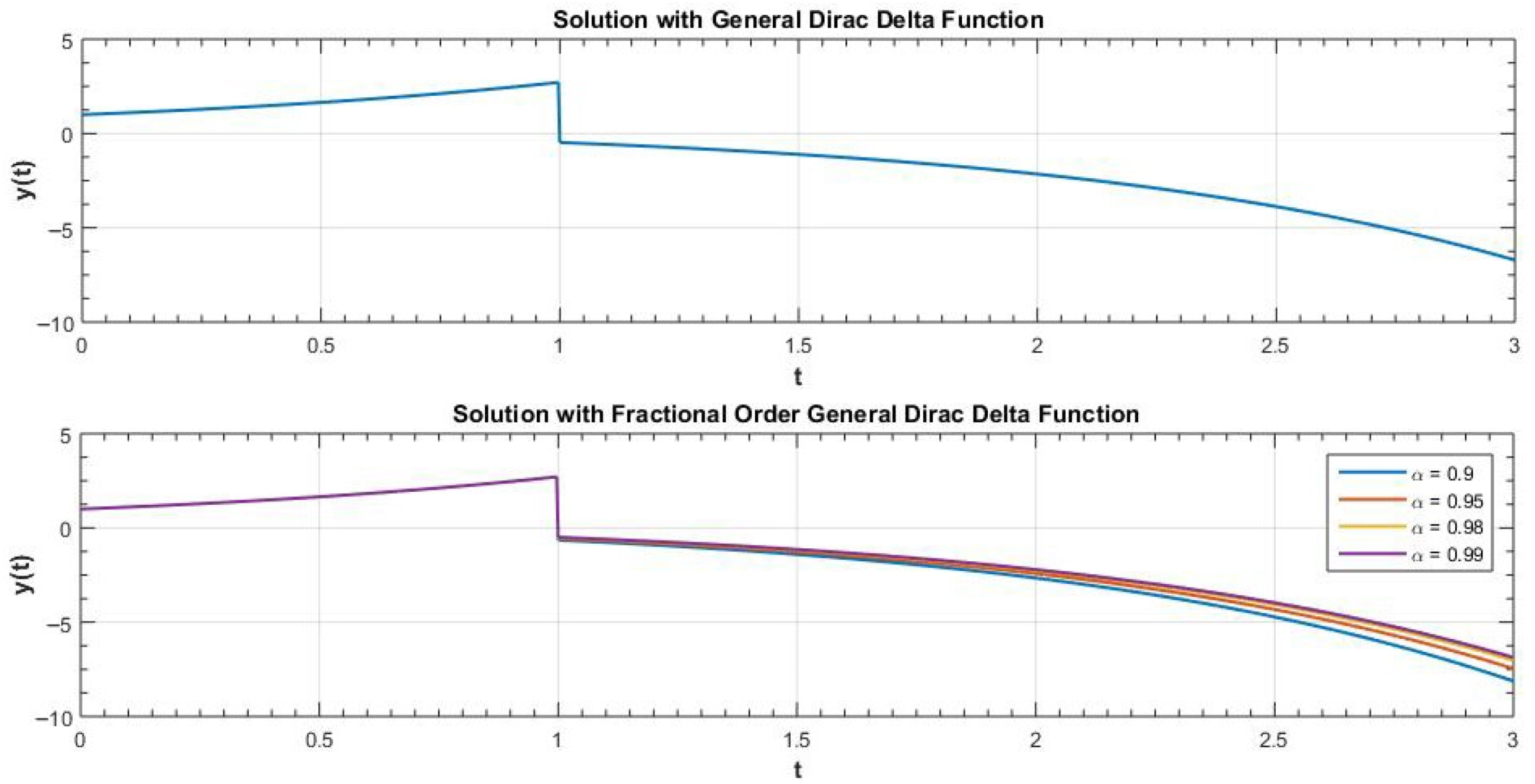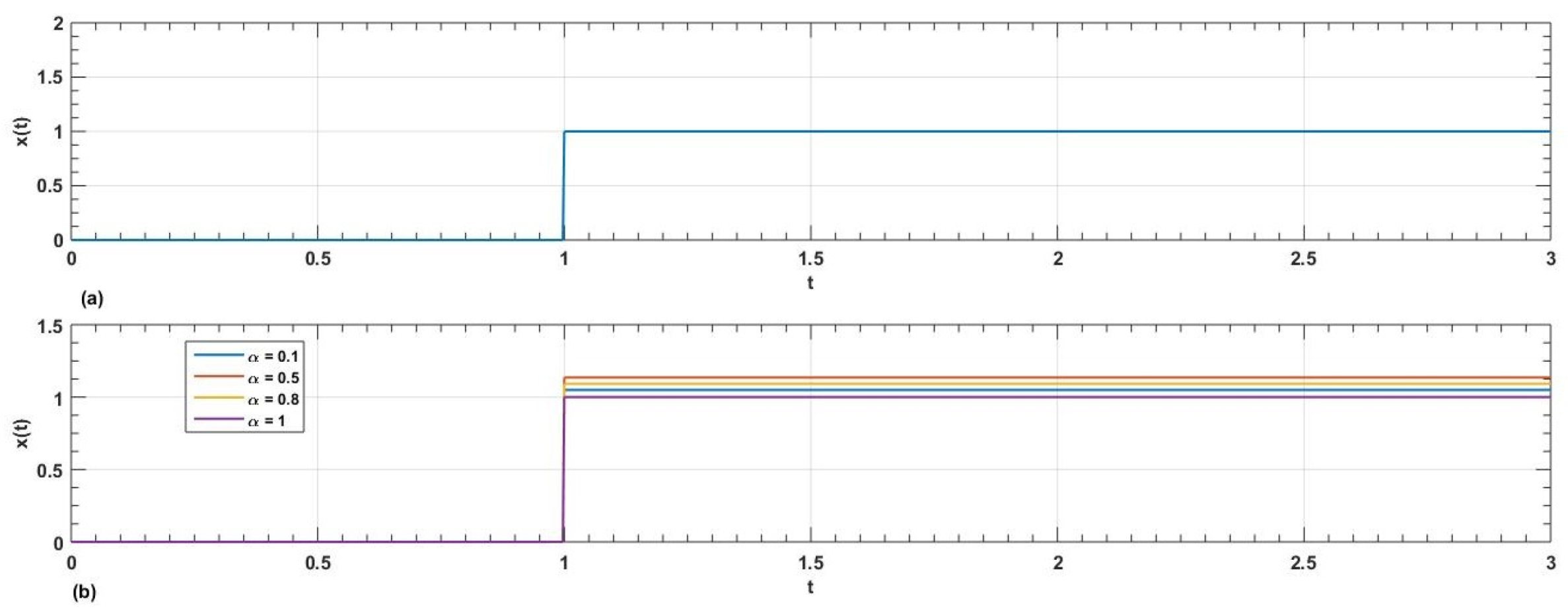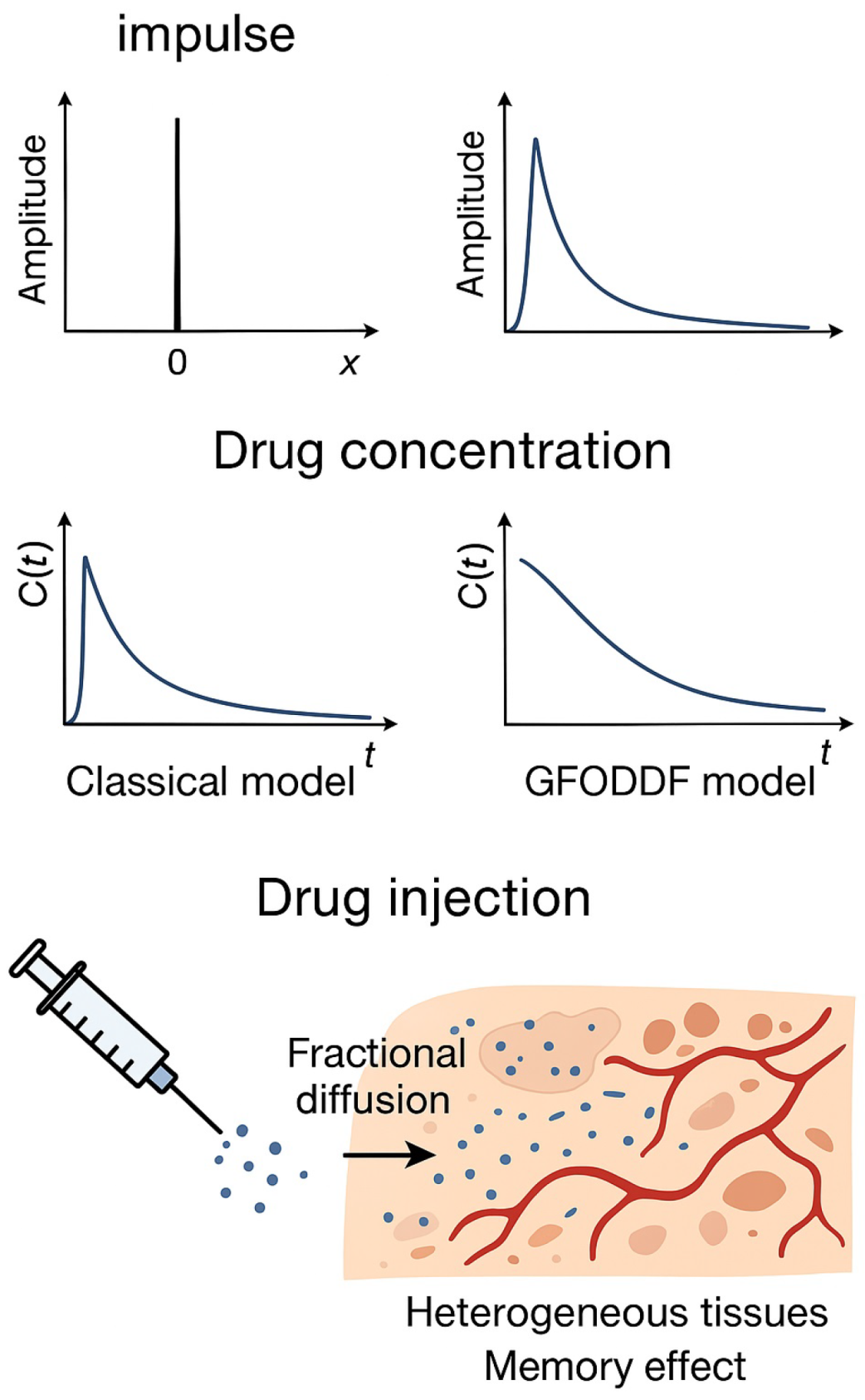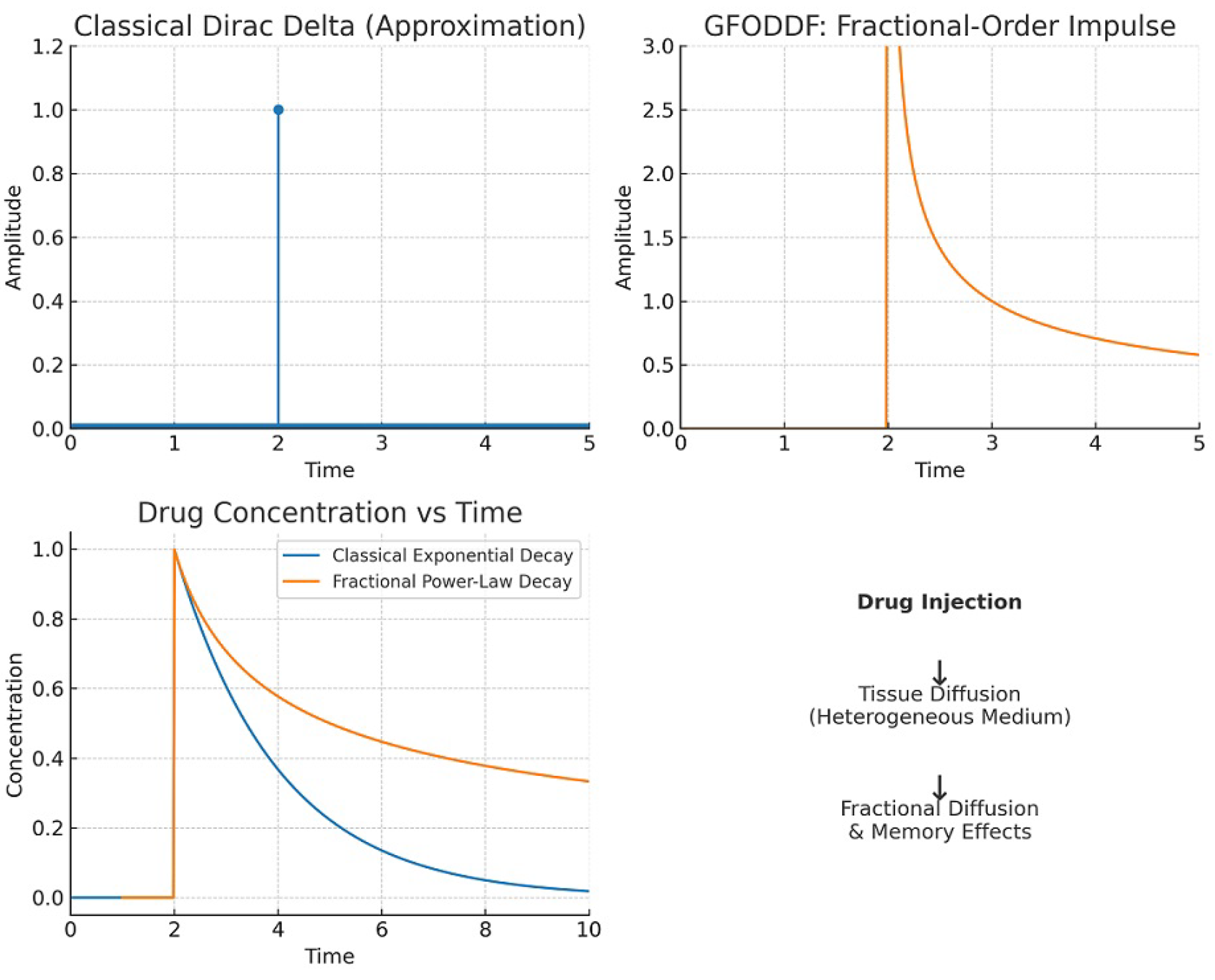On the Construction and Analysis of a Fractional-Order Dirac Delta Distribution with Application
Abstract
1. Introduction
2. Preliminaries
2.1. The Dirac Delta as a Distribution
2.2. Distributional Properties of the Dirac Delta
2.2.1. Definition
2.2.2. Basic Properties
- Support: .
- Translation: For , define the translated distribution byIn integral shorthand, represents .
- Scaling: For non-zero ,
- Derivative: The distributional derivative satisfies
- Multiplication by smooth functions: If ,(Products with non-smooth f are not defined without additional regularization.)
- Convolution: If (or, more generally, g is a rapidly decreasing smooth function), the convolution isConvolution of with another distribution is defined only when the second factor has compact support.
2.2.3. Relation to the Heaviside Function
2.3. Fractional-Order Derivatives
2.3.1. Riemann–Liouville (RL) Fractional-Order Derivatives
2.3.2. Caputo Fractional-Order Derivatives
2.3.3. Gr Ünwald–Letnikov Fractional-Order Derivative
2.4. Generalized Fractional-Order Derivative and Dirac Delta Distribution
- : order of the generalized fractional derivative, controlling the memory effect.
- : auxiliary parameter of the generalized fractional derivative that adjusts the normalization.
- : the Euler gamma function, .
2.4.1. Heaviside Step Function
2.4.2. Generalized Fractional-Order Dirac Distribution
3. Properties and Proofs of the
3.1. Shifting Property
3.1.1. Proof
3.1.2. Shifting Property in the Distributional Framework
3.2. Scaling Property
Proof
3.3. Even Function Property
3.3.1. Proof
3.3.2. Evenness Property in the Distributional Setting
3.4. Derivative Property
Proof
3.5. Zero Value Property
Proof
3.6. Convolution Property
Proof
4. Applications of in Solving Differential Equations
4.1. Solutions Using a Normal Dirac Delta Distribution and Generalized Fractional-Order Dirac Delta Distribution
4.1.1. Normal Dirac Delta Distribution
4.1.2. Generalized Fractional-Order Dirac Delta Distribution
4.2. Fractional-Order Impulse Response Solution
4.2.1. Solution of the Differential Equation Using a General Dirac Delta Distribution
4.2.2. Step-by-Step Solution
4.2.3. Final Solution
4.2.4. Solution of the Differential Equation Using the Generalized Fractional-Order Dirac Delta Distribution
4.2.5. Assumptions for Forcing Terms Involving
- Distributional Framework
- Fractional Impulse Property
- Justification for Forcing Terms
5. Application: Modeling Drug Release with Fractional Kinetics
Derivation of the Pharmacokinetic Solution (Equation (52))
- 1.
- Homogeneous solution.
- 2.
- Particular solution for the impulse at .
- 3.
- Solution for .
- 4.
- Total concentration.
6. Discussions and Conclusions
Author Contributions
Funding
Data Availability Statement
Acknowledgments
Conflicts of Interest
References
- Shutovskyi, A.M. Some applied aspects of the Dirac delta function. J. Math. Sci. 2023, 276, 685–694. [Google Scholar] [CrossRef]
- Hoskins, R.F. Delta Functions: An Introduction to Generalised Functions, 2nd ed.; Horwood Pub: Chichester, UK, 2009. [Google Scholar]
- Harris, F.E. Mathematics for Physical Science and Engineering: Symbolic Computing Applications in Maple and Mathematica; Academic Press: Cambridge, MA, USA, 2014. [Google Scholar]
- Haubold, H.J.; Mathai, A.M.; Saxena, R.K. Mittag-leffler functions and their applications. J. Appl. Math. 2011, 2011, 298628. [Google Scholar] [CrossRef]
- Chung, W.S.; Hassanabadi, H. Modified Dirac delta function and modified dirac delta potential in the quantum mechanics. Eur. Phys. J. Plus 2022, 137, 151. [Google Scholar] [CrossRef]
- Abu-Shady, M.; Kaabar, M.K. A generalized definition of the fractional derivative with applications. Math. Probl. Eng. 2021, 2021, 9444803. [Google Scholar] [CrossRef]
- Ruby; Mandal, M. The geometrical and physical interpretation of fractional order derivatives for a general class of functions. Math. Methods Appl. Sci. 2024, 47, 8400–8420. [Google Scholar] [CrossRef]
- Rodríguez, J.A.; Torres Ledesma, C.E. Mean Value and Taylor-Type Results for Tempered Fractional Derivatives. Bull. Malays. Math. Sci. Soc. 2024, 47, 82. [Google Scholar] [CrossRef]
- Miguel, V.C.; Bibi, M.; Muddassar, M.; Al-Sa’di, S. On local fractional integral inequalities via generalized (1,2)-preinvexity involving local fractional integral operators with Mittag-Leffler kernel. Demonstr. Math. 2023, 56, 20220216. [Google Scholar]
- Muddassar, M.; Dar, M.Q. Investigating synchronous function inequalities and exponential kernel-based fractional calculus in population dynamics. Adv. Inequal. Appl. 2025, 2025, 2. [Google Scholar] [CrossRef]
- Feng, Z.; Ye, L.; Zhang, Y. On the fractional derivative of Dirac delta function and its application. Adv. Math. Phys. 2020, 2020, 1842945. [Google Scholar] [CrossRef]
- Schwartz, L. Théorie des Distributions; Hermann: Paris, France, 1966. [Google Scholar]
- Gelfand, I.M.; Shilov, G.E. Generalized Functions, Vol. 1: Properties and Operations; Academic Press: New York, NY, USA, 1964. [Google Scholar]
- Strichartz, R.S. A Guide to Distribution Theory and Fourier Transforms; World Scientific: Singapore, 2003. [Google Scholar]
- Saeed, M.M.; Muddassar, M.; Mehmood, M.S.; Musharaf, H.M. Diffuse reflectance spectroscopy of γ-irradiated UHMWPE: A novel fractional order based filters approach for accessing the radiation modification. Radiat. Phys. Chem. 2022, 197, 110163. [Google Scholar] [CrossRef]
- Saeed, M.M.; Mehmood, M.S.; Muddassar, M. Fractional order ATR-FTIR differential spectroscopy for detection of weak bands and assessing the radiation modifications in gamma sterilized UHMWPE. PLoS ONE 2023, 18, e0286030. [Google Scholar] [CrossRef] [PubMed]
- Dhingra, V.; Kailey, N. Duality results for fractional variational problems and its application. Bull. Malays. Math. Sci. Soc. 2022, 45, 2195–2223. [Google Scholar] [CrossRef]
- Allagui, A.; Elwakil, A.S. Theory and Application of the Fractional-order Delta Function Associated with the Inverse Laplace Transform of the Mittag-Leffler Function. arXiv 2023, arXiv:2304.12983. [Google Scholar]
- Allagui, A.; Elwakil, A. On the Theory and Application of the Fractional-Order Dirac-Delta Function. IEEE Trans. Circuits Syst. II Express Briefs 2024, 71, 1461–1465. [Google Scholar] [CrossRef]
- Venetis, J. An analytic exact form of heaviside step function. Adv. Appl. Discrete Math 2019, 22, 153–159. [Google Scholar]










Disclaimer/Publisher’s Note: The statements, opinions and data contained in all publications are solely those of the individual author(s) and contributor(s) and not of MDPI and/or the editor(s). MDPI and/or the editor(s) disclaim responsibility for any injury to people or property resulting from any ideas, methods, instructions or products referred to in the content. |
© 2025 by the authors. Licensee MDPI, Basel, Switzerland. This article is an open access article distributed under the terms and conditions of the Creative Commons Attribution (CC BY) license (https://creativecommons.org/licenses/by/4.0/).
Share and Cite
Muddassar, M.; Jhangeer, A.; Siddiqui, N.; Mehmood, M.S.; Khan, L.; Jabeen, T. On the Construction and Analysis of a Fractional-Order Dirac Delta Distribution with Application. Axioms 2025, 14, 728. https://doi.org/10.3390/axioms14100728
Muddassar M, Jhangeer A, Siddiqui N, Mehmood MS, Khan L, Jabeen T. On the Construction and Analysis of a Fractional-Order Dirac Delta Distribution with Application. Axioms. 2025; 14(10):728. https://doi.org/10.3390/axioms14100728
Chicago/Turabian StyleMuddassar, Muhammad, Adil Jhangeer, Nasir Siddiqui, Malik Sajjad Mehmood, Liaqat Khan, and Tahira Jabeen. 2025. "On the Construction and Analysis of a Fractional-Order Dirac Delta Distribution with Application" Axioms 14, no. 10: 728. https://doi.org/10.3390/axioms14100728
APA StyleMuddassar, M., Jhangeer, A., Siddiqui, N., Mehmood, M. S., Khan, L., & Jabeen, T. (2025). On the Construction and Analysis of a Fractional-Order Dirac Delta Distribution with Application. Axioms, 14(10), 728. https://doi.org/10.3390/axioms14100728







